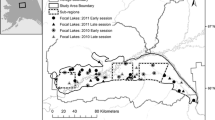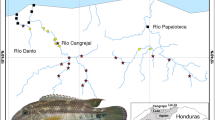Abstract
Novel communities will be formed as species with a variety of dispersal abilities and environmental tolerances respond individually to climate change. Thus, models projecting future species distributions must account for species interactions and differential dispersal abilities. We developed a species distribution model for Arctic char Salvelinus alpinus, a freshwater fish that is sensitive both to warm temperatures and to species interactions. A logistic regression model using lake area, mean annual air temperature (1961–1990), pike Esox lucius and brown trout Salmo trutta occurrence correctly classified 95 % of 467 Swedish lakes. We predicted that Arctic char will lose 73 % of its range in Sweden by 2100. Predicted extinctions could be attributed both to simulated temperature increases and to projected pike invasions. The Swedish mountains will continue to provide refugia for Arctic char in the future and should be the focus of conservation efforts for this highly valued fish.



Similar content being viewed by others
References
Araujo, M.B., and M. Luoto. 2007. The importance of biotic interactions for modelling species distributions under climate change. Global Ecology and Biogeography 16: 743–753.
Bradshaw, W.E., and C.M. Holzapfel. 2006. Climate change—Evolutionary response to rapid climate change. Science 312: 1477–1478.
Burnham, K.P., and D.R. Anderson. 2002. Model selection and multimodel inference: A practical information-theoretic approach. New York: Springer.
Byström, P., J. Karlsson, P. Nilsson, T. Van Kooten, J. Ask, and F. Olofsson. 2007. Substitution of top predators: Effects of pike invasion in a subarctic lake. Freshwater Biology 52: 1271–1280.
Chu, C., N.E. Mandrak, and C.K. Minns. 2005. Potential impacts of climate change on the distributions of several common and rare freshwater fishes in Canada. Diversity and Distributions 11: 299–310.
Ekman, S. 1922. The history of animal distributions on the Scandinavian Peninsula. Stockholm: Albert Bonniers Förlag (in Swedish).
Elliott, J.M. 1982. The effects of temperature and ration size on the growth and energetics of salmonid fish in captivity. Comparative Biochemistry and Physiology 73: 81–92.
Elliott, J.M., and J.A. Elliott. 2010. Temperature requirements of Atlantic salmon Salmo salar, brown trout Salmo trutta and Arctic charr Salvelinus alpinus: predicting the effects of climate change. Journal of Fish Biology 77: 1793–1817.
Englund, G., F. Johansson, P. Olofsson, J. Salonsaari, and J. Öhman. 2009. Predation leads to assembly rules in fragmented fish communities. Ecology Letters 12: 663–671.
Eriksson, T., J. Andersson, P. Byström, M. Hörnell-Willebrand, T. Laitila, C. Sandström, and T. Willebrand. 2006. Fish and wildlife in the Swedish mountain area—Resources, use and management. International Journal of Biodiversity and Management 2: 334–342.
Fagan, W.F. 2002. Connectivity, fragmentation, and extinction risk in dendritic metapopulations. Ecology 83: 3243–3249.
Fang, X., and H.G. Stefan. 2009. Simulations of climate effects on water temperature, dissolved oxygen, and ice and snow covers in lakes of the contiguous United States under past and future climate scenarios. Limnology and Oceanography 54: 2359–2370.
Fielding, A.H., and J.F. Bell. 1997. A review of methods for the assessment of prediction errors in conservation presence/absence models. Environmental Conservation 24: 38–49.
Filipsson, O. 1994. New fish populations as a result of stocking or spreading of fish. Information från Sötvattenslaboratoriet 2: 1–65 (in Swedish).
Finstad, A.G., T. Forseth, B. Jonsson, E. Bellier, T. Hesthagen, A.J. Jensen, D.O. Hessen, and A. Foldvik. 2011. Competitive exclusion along climate gradients: Energy efficiency influences the distribution of two salmonid fishes. Global Change Biology 17: 1703–1711.
Fry, F.E.J. 1971. The effect of environmental factors on the physiology of fish. In Fish physiology, vol. 6, ed. W.S. Hoar, and D.J. Randall. New York: Academic Press.
Gotelli, N.J., G.R. Graves, and C. Rahbek. 2010. Macroecological signals of species interactions in the Danish avifauna. Proceedings of the National Academy of Sciences of the United States of America 107: 5030–5035.
Hammar, J. 1992. The significance of the Arctic char (Salvelinus alpinus) species complex in Sweden: Distribution, biology and status of an ice-age reminiscence. In Proceedings of the seventh ISACF workshop on Arctic char, ed. P.S. Maitland, 47–63. Drottningholm: International Society of Arctic Char Fanatics.
Hanski, I. 2011. Habitat loss, the dynamics of biodiversity, and a perspective on conservation. AMBIO 40: 248–255.
Heikkinen, R.K., M. Luoto, R. Virkkala, R.G. Pearson, and J.H. Korber. 2007. Biotic interactions improve prediction of boreal bird distributions at macro-scales. Global Ecology and Biogeography 16: 754–763.
Hein, C.L., G. Öhlund, and G. Englund. 2011. Dispersal through stream networks: Modelling climate-driven range expansions of fishes. Diversity and Distributions 17: 641–651.
Hershey, A.E., G.A. Gettel, M.E. McDonald, M.C. Miller, H. Mooers, W.J. O’Brien, J. Pastor, C. Richards, et al. 1999. A geomorphic-trophic model for landscape control of Arctic lake food webs. BioScience 49: 887–897.
Hutchinson, G.E. 1957. Concluding remarks. Cold Spring Harbor Symposium on Quantitative Biology 22: 415–457.
IPCC (Intergovernmental Panel on Climate Change). 2007. Climate change 2007, Synthesis report. In Contribution of working groups I, II, and III to the fourth assessment report of the Intergovernmental Panel on Climate Change, ed. Core Writing Team, R.K. Pachauri, and A. Reisinger. Geneva, Switzerland: IPCC.
Jackson, D.A., P.R. Peres-Neto, and J.D. Olden. 2001. What controls who is where in freshwater fish communities—The roles of biotic, abiotic, and spatial factors. Canadian Journal of Fisheries and Aquatic Sciences 58: 157–170.
Jeppesen, E., K. Christoffersen, F. Landkildehus, T. Lauridsen, S.L. Amsinck, F. Riget, and M. Sondergaard. 2001. Fish and crustaceans in northeast Greenland lakes with special emphasis on interactions between Arctic charr (Salvelinus alpinus), Lepidurus arcticus and benthic chydorids. Hydrobiologia 442: 329–337.
Jonsson, M., G. Englund, and D.A. Wardle. 2011. Direct and indirect effects of area, energy and habitat heterogeneity on breeding bird communities. Journal of Biogeography 38: 1186–1196.
Jonsson, B., and N. Jonsson. 2009. A review of the likely effects of climate change on anadromous Atlantic salmon Salmo salar and brown trout Salmo trutta, with particular reference to water temperature and flow. Journal of Fish Biology 75: 2381–2447.
Kjellström, E., L. Barring, U. Hansson, C. Jones, P. Samuelsson, M. Rummukainen, A. Ullerstig, U. Willen, et al. 2005. A 140-year simulation of European climate with the new version of the Rossby Center regional atmospheric climate model (RCA3). Swedish Meteorological and Hydrological Institute, Report 108, Norrköping, Sweden.
Klemetsen, A., P.A. Amundsen, J.B. Dempson, B. Jonsson, N. Jonsson, M.F. O’Connell, and E. Mortensen. 2003. Atlantic salmon Salmo salar L., brown trout Salmo trutta L. and Arctic charr Salvelinus alpinus (L.): A review of aspects of their life histories. Ecology of Freshwater Fish 12: 1–59.
Langeland, A., J.H. Abeelund, B. Jonsson, and N. Jonsson. 1991. Resource partitioning and niche shift in Arctic charr Salvelinus alpinus and brown trout Salmo trutta. Journal of Animal Ecology 60: 895–912.
Liu, C.R., P.M. Berry, T.P. Dawson, and R.G. Pearson. 2005. Selecting thresholds of occurrence in the prediction of species distributions. Ecography 28: 385–393.
Magnuson, J.J., L.B. Crowder, and P.A. Medwick. 1979. Temperature as an ecological resource. American Zoologist 19: 331–343.
Neverman, D., and W.A. Wurtsbaugh. 1994. The thermoregulatory function of diel vertical migration for a juvenile fish, Cottus extensus. Oecologia 98: 247–256.
Nilsson, C., C.A. Reidy, M. Dynesius, and C. Revenga. 2005. Fragmentation and flow regulation of the world’s large river systems. Science 308: 405–408.
Öhman, J., I. Buffam, G. Englund, A. Blom, E. Lindgren, and H. Laudon. 2006. Associations between water chemistry and fish community composition: A comparison between isolated and connected lakes in northern Sweden. Freshwater Biology 51: 510–522.
Parmesan, C., and G. Yohe. 2003. A globally coherent fingerprint of climate change impacts across natural systems. Nature 421: 37–42.
Pearson, R.G., and T.P. Dawson. 2003. Predicting the impacts of climate change on the distribution of species: Are bioclimate envelope models useful? Global Ecology and Biogeography 12: 361–371.
R Development Core Team. 2011. R: A language and environment for statistical computing, R Foundation for Statistical Computing. Vienna: R Development Core Team. http://www.R-project.org.
Reist, J.D., F.J. Wrona, T.D. Prowse, M. Power, J.B. Dempson, R.J. Beamish, J.R. King, T.J. Carmichael, et al. 2006a. General effects of climate change on Arctic fishes and fish populations. AMBIO 35: 370–380.
Reist, J.D., F.J. Wrona, T.D. Prowse, M. Power, J.B. Dempson, J.R. King, and R.J. Beamish. 2006b. An overview of effects of climate change on selected Arctic freshwater and anadromous fishes. AMBIO 35: 381–387.
Ritchie, E.G., J.K. Martin, C.N. Johnson, and B.J. Fox. 2009. Separating the influences of environment and species interactions on patterns of distribution and abundance: Competition between large herbivores. Journal of Animal Ecology 78: 724–731.
Roeckner, E., L. Bengtsson, J. Feichten, J. Lelieveld, and H. Rodhe. 1999. Transient climate change simulations with a coupled atmosphere-ocean GCM including the Tropospheric sulfur cycle. Journal of Climate 12: 3004–3032.
Sandlund, O.T., J. Museth, T.F. Naesje, S. Rognerud, R. Saksgard, T. Hesthagen, and R. Borgstrom. 2010. Habitat use and diet of sympatric Arctic charr (Salvelinus alpinus) and whitefish (Coregonus lavaretus) in five lakes in southern Norway: Not only interspecific population dominance? Hydrobiologia 650: 27–41.
Schweiger, O., J. Settele, O. Kudrna, S. Klotz, and I. Kuhn. 2008. Climate change can cause spatial mismatch of trophically interacting species. Ecology 89: 3472–3479.
Sharma, S., D.A. Jackson, and C.K. Minns. 2009. Quantifying the potential effects of climate change and the invasion of smallmouth bass on native lake trout populations across Canadian lakes. Ecography 32: 517–525.
Spens, J., and J.P. Ball. 2008. Salmonid or nonsalmonid lakes: Predicting the fate of northern boreal fish communities with hierarchical filters relating to a keystone piscivore. Canadian Journal of Fisheries and Aquatic Sciences 65: 1945–1955.
Torgersen, C.E., D.M. Price, H.W. Li, and B.A. McIntosh. 1999. Multiscale thermal refugia and stream habitat associations of Chinook salmon in northeastern Oregon. Ecological Applications 9: 301–319.
Walther, G.R. 2010. Community and ecosystem responses to recent climate change. Philosophical Transactions of the Royal Society B-Biological Sciences 365: 2019–2024.
Yang, Z.L., E. Hanna, and T.V. Callaghan. 2011. Modelling surface-air-temperature variation over complex terrain around Abisko, Swedish Lapland: Uncertainties of measurements and models at different scales. Geografiska Annaler Series A-Physical Geography 93A: 89–112.
Acknowledgments
This research was funded by FORMAS (#2007-1149).
Author information
Authors and Affiliations
Corresponding author
Rights and permissions
About this article
Cite this article
Hein, C.L., Öhlund, G. & Englund, G. Future Distribution of Arctic Char Salvelinus alpinus in Sweden under Climate Change: Effects of Temperature, Lake Size and Species Interactions. AMBIO 41 (Suppl 3), 303–312 (2012). https://doi.org/10.1007/s13280-012-0308-z
Published:
Issue Date:
DOI: https://doi.org/10.1007/s13280-012-0308-z




